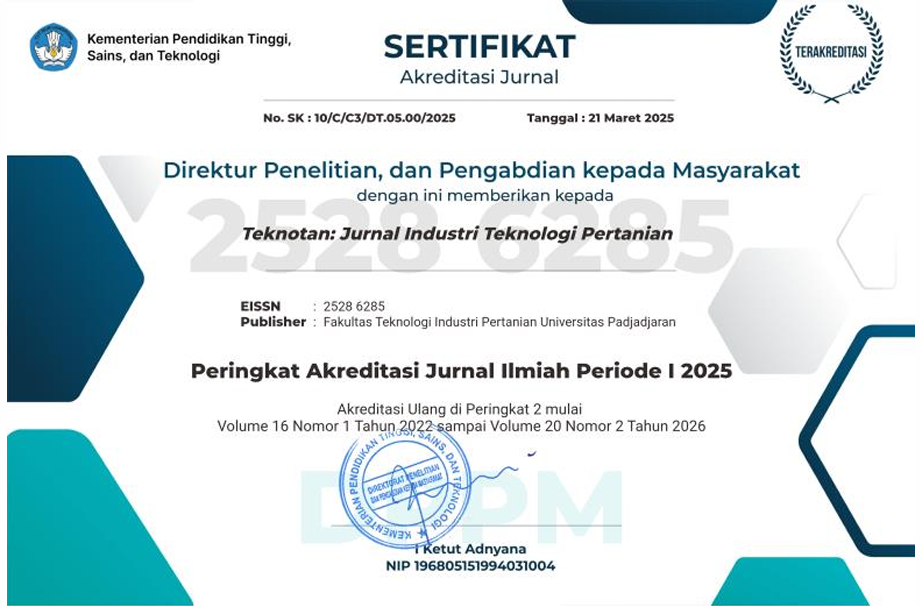Studi Miniatur Uv/Vis/Nir Spektrometer untuk Proses Kuantifikasi Mutu Biji Kopi dengan Protokol Cupping Test
Abstract
Penelitian ini menitikberatkan pada eksplorasi kemampuan spektroskopi UV/Vis/NIR untuk memprediksi parameter cupping test kualitas kopi sangrai. Sampel kopi Arabika disangrai pada suhu 198°C selama 6 menit (Light to Medium), 10 menit (Medium) dan 14 menit (Medium to Dark). Sebanyak 1 kg biji kopi disiapkan untuk tingkat waktu sangrai yang kemudian menghasilkan 20 kelompok sampel untuk menit ke-6 dan masing-masing 25 kelompok sampel pada menit ke-10 dan ke-14. Selanjutnya, dilakukan evaluasi cupping test pada kelompok sampel. Secara simultan pada kelompok sampel yang sama, dilakukan akuisisi data spektra menggunakan instrumen portable Vernier Go Direct SpectroVis Plus dan sensor MEMS (micro-electromechanical system) C12880MA. Dari hasil tersebut, menghasilkan 70 total data cupping test dan spektra yang kemudian digunakan sebagai input pembentukan model kalibrasi (prediksi). Partial Least Square Regression (PLSR) digunakan untuk membentuk model dengan Venetian blinds cross-validation 10-folds sebagai validasi internal. Hasil menunjukkan Vernier Go Direct SpectroVis Plus memiliki sensitifitas lebih baik dalam menangkap informasi yang ada pada biji kopi sangrai dan mampu memprediksi beberapa parameter cupping test yaitu Body (R2 C = 0.726, R2 CV = 0.613), Balance (R2 C = 0.738, R2 CV = 0.603) dan Overall (R2 C = 0.755, R2 CV = 0.628). Sedangkan untuk sensor MEMS C12880MA, nilai prediksi tertinggi didapat pada parameter Acidity dengan nilai R2 C dan R2 CV sebesar 0.546 dan 0.500. Berdasarkan nilai VIP Score, kontribusi terbesar dalam pembentukan model berada di rentang 760-780nm, 808-830 nm dan 843-873 nm untuk Vernier Go Direct SpectroVis Plus serta 565-637 nm dan 705-737 nm untuk MEMS C12880MA.
Keywords
Full Text:
PDF (Bahasa Indonesia)References
Aghdamifar, E., Rasooli Sharabiani, V., Taghinezhad, E., Rezvanivand Fanaei, A., & Szymanek, M. (2023). Non-destructive method for identification and classification of varieties and quality of coffee beans based on soft computing models using VIS/NIR spectroscopy. European Food Research and Technology, 249(6), 1599–1612. https://doi.org/10.1007/s00217-023-04240-x
Akarachantachote, N., Chadcham, S., & Saithanu, K. (2014). Cutoff threshold of variable importance in projection for variable selection. International Journal of Pure and Applied Mathematics, 94(3), 307–322. https://doi.org/10.12732/ijpam.v94i3.2
Basile, T., Mallardi, D., & Cardone, M. F. (2023). Spectroscopy, a Tool for the Non-Destructive Sensory Analysis of Plant-Based Foods and Beverages: A Comprehensive Review. In Chemosensors (Vol. 11, Issue 12). Multidisciplinary Digital Publishing Institute (MDPI). https://doi.org/10.3390/chemosensors11120579
Batali, M. E., Ristenpart, W. D., & Guinard, J. X. (2020). Brew temperature, at fixed brew strength and extraction, has little impact on the sensory profile of drip brew coffee. Scientific Reports, 10(1). https://doi.org/10.1038/s41598-020-73341-4
Cao, X., Wu, H., Viejo, C. G., Dunshea, F. R., & Suleria, H. A. R. (2023). Effects of postharvest processing on aroma formation in roasted coffee – a review. In International Journal of Food Science and Technology (Vol. 58, Issue 3, pp. 1007–1027). John Wiley and Sons Inc. https://doi.org/10.1111/ijfs.16261
Cardoso, W. S., Dias, S. R., Coelho, V. S., Pereira, L. L., Fioresi, D. B., & Pinheiro, F. de A. (2023). Maillard reaction precursors and arabica coffee (Coffea arabica L.) beverage quality. Food and Humanity, 1, 1–7. https://doi.org/10.1016/j.foohum.2023.01.002
Cook, D. J., Hollowood, T. A., Linforth, R. S. T., & Taylor, A. J. (2005). Correlating instrumental measurements of texture and flavour release with human perception. International Journal of Food Science and Technology, 40(6), 631–641. https://doi.org/10.1111/j.1365-2621.2005.00973.x
Geladi, P., & Kowalski, B. R. (1986). PARTIAL LEAST-SQUARES REGRESSION: A TUTORIAL. In Analytica Chimica Acta (Vol. 186). Elsevier Science Publishers B.V.
Hamamatsu. (2021). Mini-spectrometers. www.hamamatsu.com
Heydarov, S., Aydin, M., Faydaci, C., Tuna, S., & Ozturk, S. (2023). Low-cost VIS/NIR range hand-held and portable photospectrometer and evaluation of machine learning algorithms for classification performance. Engineering Science and Technology, an International Journal, 37. https://doi.org/10.1016/j.jestch.2022.101302
Laganovska, K., Zolotarjovs, A., Vázquez, M., Mc Donnell, K., Liepins, J., Ben-Yoav, H., Karitans, V., & Smits, K. (n.d.). Portable low-cost open-source wireless spectrophotometer for fast and reliable measurements. https://doi.org/10.17605/OSF.IO/RBFSE
Liang, N., Lu, X., Hu, Y., & Kitts, D. D. (2016). Application of Attenuated Total Reflectance-Fourier Transformed Infrared (ATR-FTIR) Spectroscopy to Determine the Chlorogenic Acid Isomer Profile and Antioxidant Capacity of Coffee Beans. Journal of Agricultural and Food Chemistry, 64(3), 681–689. https://doi.org/10.1021/acs.jafc.5b05682
Lingle, T. R. (2011). The coffee cupper’s handbook : systematic guide to the sensory evaluation of coffee’s flavor. Specialty Coffee Association of America.
Louzada Pereira, L., Carvalho Guarçoni, R., Soares De Souza, G., Brioschi Junior, D., Rizzo Moreira, T., & Schwengber Ten Caten, C. (2018). Propositions on the Optimal Number of Q-Graders and R-Graders. Journal of Food Quality, 2018. https://doi.org/10.1155/2018/3285452
Metrohm. (2023). Roasted and ground coffee analysis by near-infrared spectroscopy Fast determination of caffeine, water activity, and moisture. www.metrohm.com
Munyendo, L., Njoroge, D., & Hitzmann, B. (2022). The Potential of Spectroscopic Techniques in Coffee Analysis—A Review. In Processes (Vol. 10, Issue 1). MDPI. https://doi.org/10.3390/pr10010071
Navarra, G., Moschetti, M., Guarrasi, V., Mangione, M. R., Militello, V., & Leone, M. (2017). Simultaneous determination of caffeine and chlorogenic acids in green coffee by UV/Vis spectroscopy. Journal of Chemistry, 2017. https://doi.org/10.1155/2017/6435086
Nunes, K. M., Andrade, M. V. O., Almeida, M. R., Fantini, C., & Sena, M. M. (2019). Raman spectroscopy and discriminant analysis applied to the detection of frauds in bovine meat by the addition of salts and carrageenan. Microchemical Journal, 147, 582–589. https://doi.org/10.1016/j.microc.2019.03.076
Pujantoro, L. E., & Ahmad, U. (2019). Predicting Lipid, Caffeine And Chlorogenic Acid Contents Of Arabica Coffee Using NIRS. INTERNATIONAL JOURNAL OF SCIENTIFIC & TECHNOLOGY RESEARCH, 8, 8. www.ijstr.org
Safrizal, Sutrisno, S., Lilik, P. E. N., Ahmad, U., & Samsudin, S. (2018). Estimation of Sensory Analysis Cupping Test Arabica Coffee Using NIR Spectroscopy. IOP Conference Series: Earth and Environmental Science, 147(1). https://doi.org/10.1088/1755-1315/147/1/012008
SCA (Specialty Coffee Association). (2017). Arabica Cupping Form. https://sca.coffee/member-assets
Shan, J., Suzuki, T., Suhandy, D., Ogawa, Y., & Kondo, N. (2014). Chlorogenic acid (CGA) determination in roasted coffee beans by Near Infrared (NIR) spectroscopy. Engineering in Agriculture, Environment and Food, 7(4), 139–142. https://doi.org/10.1016/j.eaef.2014.08.003
Ulinnuha, A. R. I., Bahtiar, Z. A., Nauri, A. R., Rhamadan, I., Wulansari, R. C., & Iqbal, Z. (2021). The performance of the C12880MA MEMS sensor for classification of the roasting level of coffee bean. IOP Conference Series: Earth and Environmental Science, 924(1). https://doi.org/10.1088/1755-1315/924/1/012021
Williams P, A. J. M. M. (2019). Near Infrared Technology: Getting the best out of light (First Edition). AFRICAN SUN MeDIA.
Zhu, C., Fu, X., Zhang, J., Qin, K., & Wu, C. (2022). Review of portable near infrared spectrometers: Current status and new techniques. In Journal of Near Infrared Spectroscopy (Vol. 30, Issue 2, pp. 51–66). SAGE Publications Ltd. https://doi.org/10.1177/09670335211030617
DOI: https://doi.org/10.24198/jt.vol18n1.1
Refbacks
- There are currently no refbacks.
Indexed by:

This work is licensed under a Creative Commons Attribution 4.0 International License (CC BY-SA 4.0)


1.png)
.png)







